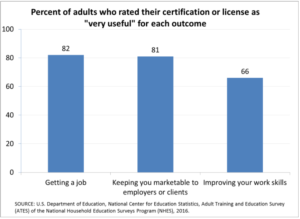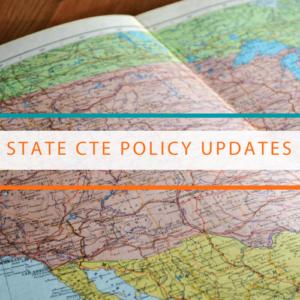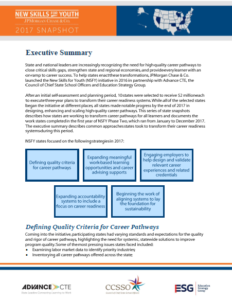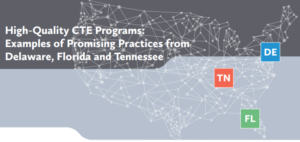The National Center for Education Statistics recently released a new report summarizing the results from the 2016 Adult Training and Education Survey, which gathered nationally representative data on U.S. adults’ training and education.
 Overall, 27 percent of adults aged 16-65 have a nondegree credential, with 21 percent having an occupational certification or license and 8 percent having a postsecondary certificate. Among those who have an occupational certification or license, 67 percent prepared for their most important certification or license by taking classes from a college, technical school or trade school. Additionally, 21 percent of adults have completed an apprenticeship or internship, with 14 percent doing so as part of an educational program after high school.
Overall, 27 percent of adults aged 16-65 have a nondegree credential, with 21 percent having an occupational certification or license and 8 percent having a postsecondary certificate. Among those who have an occupational certification or license, 67 percent prepared for their most important certification or license by taking classes from a college, technical school or trade school. Additionally, 21 percent of adults have completed an apprenticeship or internship, with 14 percent doing so as part of an educational program after high school.
According to the NCES’ blog post on the survey, “the data show that nondegree credentialing and work experience programs are particularly common in the healthcare field. In fact, health care was the most common field in which both certifications and licenses were held and the most common field for which adults had completed a work experience program.
The ATES also found that adults perceive nondegree credentials to be useful for many labor market outcomes. For example, 82 percent of adults who have a certification or license reported that it was very useful for ‘getting a job’, 81 percent reported that it was very useful for ‘keeping you marketable to employers or clients’, and 66 percent reported it that was very useful for ‘improving your work skills.’”
University Innovation Alliance Expected to Exceed Public Attainment Goals
A recent article highlights the successes of the University Innovation Alliance (UIA), a group of 11 research universities who banded together to implement strategies that would help more low-income students complete postsecondary programs. Over the past three years, the universities have increased the number of low-income graduates at their institutions by 24.7 percent, and they are on track to surpass their initial goal of increasing the number of low-income graduates by 34,000 students.
Among other strategies, the universities encouraged students to take a minimum of 15 credits per semester to increase their likelihood of completion and shared data analyses and studies with each other to help problem-solve. Their approach has had noticeable effects, even over a short time period. A comparative study recently revealed that 31 percent of the UIA undergraduate students receive Pell Grants compared to 15 percent of undergraduates at Ivy League institutions and at 50 other selective liberal arts colleges. This information is significant in that these 11 research universities are serving vastly more low-income students than many universities, and they are actively committed to helping those students succeed.
Odds and Ends
The Bureau of Labor Statistics recently released a report showing the current and projected entry-level degree requirements for various employment sectors. Interestingly, 6.5 percent of entry-level employment in 2016 was in occupations that typically require postsecondary education for entry. From May 2007 to May 2016, the share of U.S. employment in occupations typically requiring a high school diploma or equivalent for entry fell by nearly 2.6 percentage points, from over 38.3 percent to slightly less than 35.8 percent. Over the same period, the share of employment in occupations typically requiring postsecondary education for entry rose by 2.3 percentage points, from 34.2 to 36.5 percent.
Gallup and the Strada Education Network released a report diving into how individuals choose their field of study, based on a survey of 22,000 adults. Respondents were asked from where they received advice about their major, with responses falling into four main groups: formal, informal social network, informal school-based and informal work-based. Somewhat surprisingly, the survey found that the majority of adults used their informal social networks for advice, rather than the more formal (and likely more helpful and informed) channels available to them.
More great news has emerged for the Tennessee Promise program, as results on student outcomes continue to come in. Fifty-six percent of Tennessee Promise students who entered college in 2015, the program’s first year, had graduated, transferred to a four-year university or remained in school two years later. Only 39 percent of recent high school graduates outside of Tennessee Promise had done the same — a difference of 17 percentage points. While officials agree there is still more work to do, they are encouraged by these results.
Ashleigh McFadden, State Policy Manager
 Throughout history, and continuing today, learners of color, low-income learners, female learners and learners with disabilities have been historically tracked into terminal vocational programs leading to jobs with uncertain promise of economic growth and prosperity. Today, the quality of Career Technical Education (CTE) has vastly improved, making it a preferred path for many secondary and postsecondary learners. Yet even today, many learners do not have access to high-quality programs of study in their communities. To help state leaders recognize historical barriers and adopt promising solutions to close equity gaps in CTE, Advance CTE launched a series of policy briefs titled Making Good on the Promise. The first three briefs in the series explored the history of inequities in CTE, highlighted promising practices from states that are using data to identify and close equity gaps, and explored how state leaders can build trust with historically marginalized communities that may not believe in the promise and value of CTE.
Throughout history, and continuing today, learners of color, low-income learners, female learners and learners with disabilities have been historically tracked into terminal vocational programs leading to jobs with uncertain promise of economic growth and prosperity. Today, the quality of Career Technical Education (CTE) has vastly improved, making it a preferred path for many secondary and postsecondary learners. Yet even today, many learners do not have access to high-quality programs of study in their communities. To help state leaders recognize historical barriers and adopt promising solutions to close equity gaps in CTE, Advance CTE launched a series of policy briefs titled Making Good on the Promise. The first three briefs in the series explored the history of inequities in CTE, highlighted promising practices from states that are using data to identify and close equity gaps, and explored how state leaders can build trust with historically marginalized communities that may not believe in the promise and value of CTE.

 As the legislative session moves forward, states have passed laws to increase awareness of and expand access to Career Technical Education (CTE) opportunities for each learner.
As the legislative session moves forward, states have passed laws to increase awareness of and expand access to Career Technical Education (CTE) opportunities for each learner. The points an institution receives in the formula for credential attainment are multiplied if the credentials are in Science, Technology, Engineering and Mathematics (STEM) or state-defined “high-demand” fields. Qualifying fields are designated by the the Arkansas Department of Higher Education and the Department of Workforce Services. The multiplier for STEM degrees is 3 points; the multiplier for degrees in high-demand fields is 1.5 points.
The points an institution receives in the formula for credential attainment are multiplied if the credentials are in Science, Technology, Engineering and Mathematics (STEM) or state-defined “high-demand” fields. Qualifying fields are designated by the the Arkansas Department of Higher Education and the Department of Workforce Services. The multiplier for STEM degrees is 3 points; the multiplier for degrees in high-demand fields is 1.5 points.  What defines a high-quality career pathway? Is it alignment to labor market needs and career opportunities? The quality and qualifications of teachers and faculty? Access to meaningful, aligned work-based learning experiences? Perhaps all of the above?
What defines a high-quality career pathway? Is it alignment to labor market needs and career opportunities? The quality and qualifications of teachers and faculty? Access to meaningful, aligned work-based learning experiences? Perhaps all of the above? 

 Overall, 27 percent of adults aged 16-65 have a nondegree credential, with 21 percent having an occupational certification or license and 8 percent having a postsecondary certificate. Among those who have an occupational certification or license, 67 percent prepared for their most important certification or license by taking classes from a college, technical school or trade school. Additionally, 21 percent of adults have completed an apprenticeship or internship, with 14 percent doing so as part of an educational program after high school.
Overall, 27 percent of adults aged 16-65 have a nondegree credential, with 21 percent having an occupational certification or license and 8 percent having a postsecondary certificate. Among those who have an occupational certification or license, 67 percent prepared for their most important certification or license by taking classes from a college, technical school or trade school. Additionally, 21 percent of adults have completed an apprenticeship or internship, with 14 percent doing so as part of an educational program after high school.  A little over one year ago, Advance CTE launched
A little over one year ago, Advance CTE launched  States across the nation are moving towards the direction of competency-based learning systems, but too often this work is undertaken with the mindset that academic and CTE courses are separate systems.
States across the nation are moving towards the direction of competency-based learning systems, but too often this work is undertaken with the mindset that academic and CTE courses are separate systems.  This first principle of
This first principle of